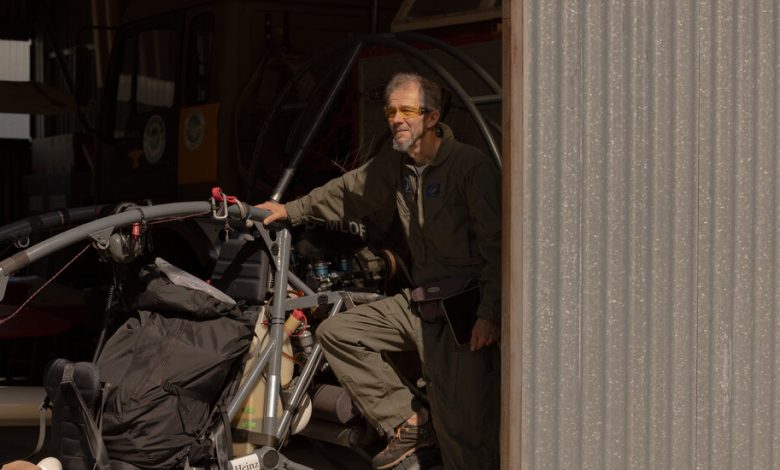To Stop an Extinction, He’s Flying High, Followed by His Beloved Birds

Johannes Fritz, a maverick Austrian biologist, needed to come up with a plan, and quickly, if he was going to prevent his rare and beloved birds from going extinct, again.
To survive the European winter, the northern bald ibis — which had once disappeared entirely from the wild on the continent — needs to migrate south for the winter, over the Alps, before the mountains become impassable.
But shifting climate patterns have delayed when the birds begin to migrate, and they are now reaching the mountains too late to make it over the peaks, locking them in an icy death trap.
“Two or three years, and they’d be extinct again,” Mr. Fritz said.
Determined to save them, Mr. Fritz decided he would teach the birds a new, safer migration route by guiding them himself in a tiny aircraft. And he was confident he could succeed in this daring, unconventional plan — because he had done it before.
When Mr. Fritz was born 56 years ago, the northern bald ibis, a goose-sized black bird with a bald head and an enormous beak, could be found in Europe only in captivity. Some 400 years ago, Europeans likely devoured the last of them.
But Mr. Fritz has spent his career reintroducing the birds into the wild, and an essential part of their education has been teaching the young the migration path they will follow as adults.
Mr. Fritz learned to fly, modifying an ultralight aircraft so it would cruise at speeds slow enough for his winged students to keep up.
He was his young pupils’ sole provider of food, love and cuddles since they’d been just a few days old, and the ibises eagerly followed their teacher — who just happens to pilot a fairly noisy machine.
In 2004, three years after some initially bumpy experiments, Mr. Fritz led the first flock from Austria to Italy, and has since led 15 such migrations. Over that time, he has rewilded 277 young ibises, many of which then started to pass the route on to their own young.
But the route he originally taught the ibises is no longer viable. With climate change warming the area where the birds summer — by Lake Constance in Germany and Austria — they now start their migration at the end of October instead of the end of September, as they had done just a decade ago.
Last year, as he followed the birds’ progress, Mr. Fritz found snow covering the ibises’ feathers, and their long beaks struggled to find larvae and worms in the frosty soil. Three colonies of ibises each tried two times to traverse the mountains in November, but failed every time, with Mr. Fritz hypothesizing that rising warm air flows were too weak by November to allow the birds to soar with ease over the mountains.
Mr. Fritz and his team lured the ravenous animals with mealworms, trapped them in crates and chauffeured them over the Alps.
But a private coach service, Mr. Fritz realized, wasn’t a sustainable solution, and so he came up with the idea to show the birds a new migration path.

One of the ibises’ foster mothers, feeding chicks.CreditCredit…Waldrappteam Conservation and Reserach
At Lake Constance this summer, humans and birds were in flight school, practicing the escorted flights for their epic journey. By October, they hope to reach Spain’s southern Atlantic coast, by Cadiz, where the birds could comfortably winter.
Bypassing the mighty Alps, the new route is about 2,500 miles, or some three times longer than their previous one directly south to Tuscany. Flying at a maximum speed of 25 miles per hour, the trip is expected to take about six weeks, as opposed to the two to reach Tuscany.
Still, “we’re optimistic that it’ll work,” said Mr. Fritz as he pushed his aircraft on a meadow that serves as landing strip.
His aircraft is a three-wheeled vehicle attached to a propeller and canopy resembling a parachute, but Mr. Fritz insists it’s safe — and unlike the gliders in which he learned to fly, it doesn’t make him sick.
Growing up on a mountain farm in Tyrol, Mr. Fritz enjoyed watching how cows and horses interacted with each other more freely — nuzzling and playing — once they’d been led out of the barn and into pasture. These boyhood observations fostered his dream of becoming a biologist.
At 20, he enrolled in a program that would eventually allow him to study biology at university but first, he had to train as a state hunter with responsibility for keeping local animal populations in check.
In rough Alpine terrain, he monitored the health of chamois and deer herds, while refusing to kill them. Only once, at the repeated insistence of his boss, did he ever pull the trigger. “An orphaned fawn, which would have died,” said Mr. Fritz, who called the shooting a “dark spot” in his professional life.
He was 24 when he finally began studying at universities in Vienna and Innsbruck. He later landed work at Austria’s Konrad Lorenz Research Center, raising raven chicks by hand and teaching graylag geese how to open boxes as he pursued his Ph.D. Working this closely with free-living animals was exactly what he’d dreamed of as a boy.
In 1997, a zoo gave the research center its first northern bald ibis chicks. Nowhere near as teachable as geese — and not even close to superintelligent ravens — the ibises frustrated most of the scientists.
But Mr. Fritz was enamored. When people joke that their red, wrinkled heads and black mohawks put them in the running for world’s ugliest bird, he points to their charisma, gregariousness and affection. He knows what chicks love to eat — shredded mice and beef heart, eight times a day — and the curious birds enjoy poking their long beaks gently into his ears.
After the ibises were first released back into the wild more than 20 years ago, Mr. Fritz learned that spending generations in zoological confinement hadn’t abated their drive to migrate, though it did leave them geographically uninformed. In their search for “south,” some ended up in Russia.
What the ibises needed, Mr. Fritz thought, was a guide.

Aircrafts leading a formation of northern bald ibises.CreditCredit…Waldrappteam Conservation and Reserach
“Around that time, ‘Fly Away Home’ was a huge hit with us biologists,” Mr. Fritz says, recalling the 1996 movie in which characters played by Jeff Daniels and Anna Paquin lead the migration of orphaned Canada geese in a hang glider. When Mr. Fritz proclaimed he’d do the same with the ibises, he was initially ridiculed.
But through years of trial and error,he succeeded. He even learned to fly like a bird, he said, soaring with ease.
Mr. Fritz’s two sons, both now teenagers, followed their flying father and the migrating birds on the ground, and his family and colleagues witnessed the risks he was taking.
“Luckily, whenever the motor stopped working, we were somewhere we could still land,” Mr. Fritz said. Once, he crashed so hard into a cornfield, his team feared him dead. When they found him nearly unscathed in a wrecked aircraft, his first response was: “We need to get this fixed immediately.”
Today, he prioritizes safety, he said, in part because he is no longer the only one taking the risks. The ibises are now raised by two research assistants who function as human foster mothers, one flying in the back of Mr. Fritz’s aircraft, the other with a second pilot.
On a blistering hot morning at their Lake Constance campsite, Mr. Fritz zipped up his olive-green jumpsuit and hopped into his aircraft, turning around to check on the 35 ibises and signaling for one of the foster mothers to get in the seat behind him. As they rise above the grassy airstrip, the birds flap their black wings, following just behind.
Soon, they’ll fly west to France, then south to the Mediterranean, where they’ll trace the coast all the way to Andalusia, one of the hottest and driest regions on the continent, dealing with unpredictable weather along the way.
But the inevitable risks are “necessary,” Mr. Fritz said.
“It’s not so much a job,” he added, “but my life’s purpose.”





